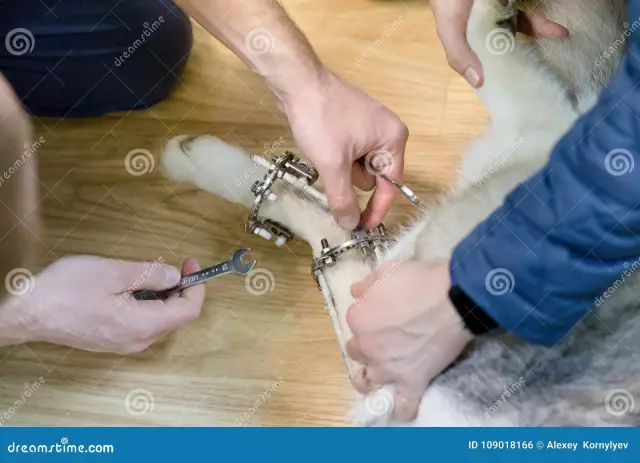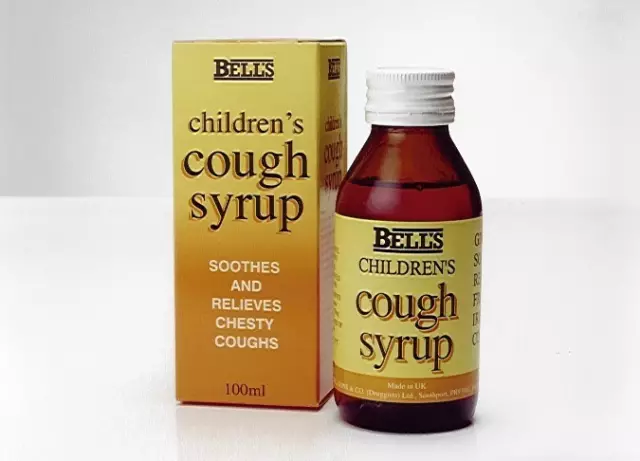- Author Rachel Wainwright [email protected].
- Public 2023-12-15 07:39.
- Last modified 2025-11-02 20:14.
Molluscum contagiosum in children
The content of the article:
- Causes and risk factors
- Symptoms
- Diagnostics
- Treatment of molluscum contagiosum in children
- Dr. Komarovsky on the treatment of molluscum contagiosum in children
- Potential consequences and complications
- Forecast
- Prevention
Molluscum contagiosum in children is an infectious dermatosis caused by a virus belonging to the smallpox family. The disease is manifested by the appearance on the skin of dense small nodules with a small depression in the central part.

Symptoms of molluscum contagiosum in children
Molluscum contagiosum in children is much more common than in adults. According to medical statistics, 80% of all cases of the disease occur in the age group from 2 to 12 years. Children of the first year of life are not susceptible to the disease, since they are protected by antibodies obtained from the mother in utero and with breast milk.
Molluscum contagiosum in children does not pose a serious health hazard and in most cases does not require treatment, as it tends to resolve spontaneously within 6-24 months.
The disease is recorded in all countries of the world, but is most often recorded in regions with a humid and hot climate, as well as in developing countries with a low standard of living and insufficiently developed hygienic skills of the population.
Causes and risk factors
The causative agent of molluscum contagiosum is an orthopoxivirus belonging to the Poxviridae family. The viruses that cause chickenpox, natural smallpox, and monkeypox also belong to this family. There are 4 strains of molluscum contagiosum virus - MCV-1, MCV-2, MCV-3, MCV-4, the most common of them are the first two (MCV-1 and MCV-2), and MCV-1 is usually found in children, and MCV-2 is more common in adults.
The virus is transmitted from person to person through household contact (through the use of shared bath accessories, toys, underwear, close skin-to-skin contact). Often, children become infected with molluscum contagiosum when they visit the pool. Virus inoculation promotes skin microtrauma, which is why molluscum contagiosum more often affects children with skin diseases, such as eczema or prickly heat.

It is not uncommon for children to contract molluscum contagiosum in the pool
After infection, the virus enters the keratinocytes of the epidermis, where it begins to actively synthesize its DNA. In the future, it suppresses the activity of T-lymphocytes, which explains the slow production of antibodies to it by the body.
There are a number of diseases that increase the risk of molluscum contagiosum in children. These include:
- immunodeficiency states of various etiologies, including after infectious diseases, as well as with HIV infection;
- allergic diseases;
- systemic (autoimmune) diseases.
The risk group includes children receiving therapy with corticosteroids and / or cytostatics - that is, drugs that suppress the immune system.
Symptoms
The incubation period for molluscum contagiosum in children lasts from 15 to 180 days. After its completion, single rounded nodules of dense consistency are formed on the skin, ranging in size from a millet grain to a large pea with a slightly depressed center. The color of the skin above them is usually unchanged, but in some cases it becomes slightly pinkish or pinkish-orange, sometimes acquiring a waxy or pearlescent sheen.
Over time, the number of nodules increases. Individual elements can merge with each other, which leads to the appearance of large elements, which are hemispherical papules with a depressed central part. If you press on the knot with tweezers, then a small amount of white mushy mass will come out of it. It consists of lymphocytes and keratinized cells. When examining this mass under a microscope, it is possible to notice the presence of rounded inclusions in it, which are called mollusc-like bodies and gave the name to this disease.
The elements of molluscum contagiosum in children are arranged in a chaotic manner, and their number can be in the hundreds. Initially, the nodules are located in the area of the virus. Later they appear on the skin of the upper body, neck, face and hands. Involuntary scratching contributes to further self-infection and an increase in the number of new rashes.
In most cases, molluscum contagiosum in children is not accompanied by the appearance of any unpleasant sensations. Only occasionally can there be slight skin infiltration and mild itching. There are no general symptoms.

It looks like molluscum contagiosum in children
Skin rashes with an atypical form of molluscum contagiosum in children are very small (miliary form), in this case they lack a concave center. Children who are weakened, suffering from leukemia, atopic dermatitis, and HIV infection may develop a profuse (generalized) form of the disease.
Diagnostics
Diagnosis of molluscum contagiosum in children usually does not cause difficulties and is carried out by a dermatologist based on the presence of characteristic rashes on the skin.
In difficult diagnostic cases, a laboratory examination of the detachable nodules is carried out. Confirmation of the diagnosis is the detection of mollusc bodies (the so-called Lipschütz mollusc bodies - degenerative ovoid epithelial cells containing large protoplasmic inclusions).
Molluscum contagiosum in children requires differential diagnosis with viral warts, multiple keratoacanthoma and lichen planus.
Treatment of molluscum contagiosum in children
The complexity of treating molluscum contagiosum in children is due to the fact that the causative agent of the disease is a DNA-containing virus. To date, there is no way to completely rid the body of it, that is, the disease belongs to chronic pathologies. However, it is quite possible to prevent the occurrence of relapses. To do this, it is necessary to carry out activities aimed at strengthening the general body of children and increasing immune protection:
- normalization of the daily routine;
- balanced diet;
- regular stay in the fresh air;
- course intake of multivitamin preparations.
Treatment of molluscum contagiosum in children involves the use of antiviral agents. Basically, they are applied topically in the form of ointments, creams, and only in severe cases (profuse form of infection) there are indications for systemic antiviral therapy.

For the treatment of molluscum contagiosum, local antiviral agents are most often prescribed
The removal of molluscum contagiosum in children is currently rarely resorted to, since over time the rash disappears from the skin on its own. If necessary, deletion can be performed using one of the following methods:
- Curettage. It is performed under local application anesthesia. At one time it is possible to remove a significant number of skin nodules, since the procedure is not too painful and less traumatic. Curettage can be performed no more than once a month. Complete elimination of the elements of the rash is achieved in several sessions.
- Cryodestruction. Removal of molluscum contagiosum in children by exposing them to ultra-low temperatures provided with liquid nitrogen.
- Removal by laser.
With a small number of rashes, the therapeutic effect can be achieved by irradiating the affected areas of the skin with ultraviolet light.
Also, in order to remove molluscum contagiosum in children, a new technique is used, which consists in applying tuberculin to the affected skin areas. Before starting treatment, children must receive the BCG vaccine, and during therapy they are prescribed Isoprinosine. Due to the fact that the method of treating molluscum contagiosum in children with tuberculin applications has been used recently, there is still not enough data on its effectiveness and safety in the long-term period.
Antibiotics for molluscum contagiosum in children are prescribed only in the case of a secondary purulent infection.
Dr. Komarovsky on the treatment of molluscum contagiosum in children
Many pediatricians, including E. O. Komarovsky, believe that molluscum contagiosum in children does not require any medical manipulations. According to Dr. Komarovsky, over time, the child's body cope with the infection on its own, and the disease, after 6-18 months, goes into remission, which in many cases continues throughout life. To speed up this process, general strengthening measures are recommended, and to prevent self-infection and the spread of a rash, it is enough to treat the elements with antiviral ointments. In the case of itching, antihistamines are justified to prevent scratching of the affected skin areas.

Dr. Komarovsky believes that removing molluscum contagiosum in children can spread the infection
EO Komarovsky claims that when removing molluscum contagiosum from children by any method known today, it is impossible to avoid further spread of infection. In addition, the artificial removal of the elements of the rash often leads to the formation of rough scars on the baby's skin that remain for life. If the skin rashes go away on their own, this is not observed.
Potential consequences and complications
Complications with molluscum contagiosum are extremely rare. Most often they occur in children with weakened immunity and are associated with the addition of a secondary infection at the site of scratching, which causes the development of purulent complications (abscesses, phlegmon).
Forecast
The prognosis for molluscum contagiosum in children is favorable. With the addition of purulent complications on the skin, rough scars and spots with impaired pigmentation may subsequently remain.
Given the fact that the disease most often affects children with weakened immunity, a medical examination of the child is required in order to establish the cause of the immunodeficiency. The presence of a profuse form of the disease or giant contagious molluscs is the basis for an HIV test.
Prevention
Prevention of molluscum contagiosum in children includes:
- careful adherence to the rules of personal hygiene and home hygiene (use only personal washcloths and towels, weekly bed linen change, daily underwear change, daily shower);
- isolation of a sick child from the children's team;
- regular preventive examinations of the skin of children in organized groups (kindergartens, schools);
- obligatory shower after visiting the pool, public bath.
Parents should check their children's skin regularly. When rashes appear on it, resembling molluscum contagiosum, a dermatologist's consultation is necessary. If the diagnosis is confirmed, separate dishes, towels, toys are allocated for the child. Close physical contact should not be allowed between him and other family members. Children with molluscum contagiosum are not recommended to use the swimming pool or public baths. Compliance with these rules greatly reduces the transmission of infection from a sick child to other people.
YouTube video related to the article:

Elena Minkina Doctor anesthesiologist-resuscitator About the author
Education: graduated from the Tashkent State Medical Institute, specializing in general medicine in 1991. Repeatedly passed refresher courses.
Work experience: anesthesiologist-resuscitator of the city maternity complex, resuscitator of the hemodialysis department.
The information is generalized and provided for informational purposes only. At the first sign of illness, see your doctor. Self-medication is hazardous to health!






